Facilitating stakeholders and community involvement in a Satoyama landscape
16.11.2011
-
SUBMITTED ORGANISATION :
-
The Nomi Satoyama Conservation Society (NSCS)
-
DATE OF SUBMISSION :
-
16/11/2011
-
REGION :
-
Eastern Asia
-
COUNTRY :
-
Japan (Nomi City, Ishikawa Prefecture)
-
SUMMARY :
-
The Satoyama region in Nomi includes planted forest, secondary forest and paddy fields, which include many rare and endangered species, and which have been relatively unaffected by development in recent decades. Basic management of planted forests has been maintained, but with the aging population, maintenance of woods and many agricultural fields has been neglected. The Nomi Satoyama Conservation Society(NSCS), works to promote the protection, support and managed use of the Satoyama area resources. It has organized tree planting and forest management projects, conducted natural farming methods research, opened the Satoyama Nature School, and is working to preserve such traditional local crafts as charcoal-making. The NSCS has also helped to promote pesticide free agriculture, and partnerships between people in the Satoyama areas and people from the urban areas who are encouraged to rent and cultivate abandoned agricultural land at low cost. Creating regular opportunities for exchanges between the NSCS members and local residents has helped bring community support to the Satoyama area promotion activities, despite initial resistance from local communities to land cultivation by outsiders or activities that invite many people to the area. The NSCS has established strong partnerships with three Satoyama communities, and wishes to continue to expand its support for projects and activities that suit the local communities.
-
KEYWORD :
-
Community, natural resources, neglected field, partnership
-
AUTHOR:
-
Masatomo Ogawa President/Owner Naturebrand-Planning Environmental Education Office Satoyama Planning Director of Nomi SATOYAMA Conservation Society Council for Outdoor and Nature Experiences, Trainer Specialties are enviromental education, human resource development and skills in outdoor and nature experiences, and woodstoves.
1. Satoyama Area of Nomi City, Ishikawa Prefecture, Japan
1.1 Outline of the Region
Nomi City’s Satoyama area is located in the center of Kaga plains which is situated in the south of Ishikawa Prefecture. The area to the east of Nomi is an alluvial fan sandwiched between the Tedori River flowing from the Hakusan mountain range and the Kakehashi River; the gentle sloped hilly areas of Nomi stretch out to the Hakusan mountain range. The City of Nomi is located 20 km south-west of Kanazawa which is the capital city of Ishikawa. To the north of Nomi lies the river Tedori (Hakusan City/Kawakita Town), while to the south lie hilly areas; the Nomi Hills (50 ~ 400m Satoyama) lie in the east and the urban areas of Nomi lie in the west, all of which are a part of Nomi’s Satoyama region. Komatsu Airport is the aerial gateway of Ishikawa and is only 15 km from Nomi; Kanazawa city is also just about 20 km from Nomi. Since Nomi is situated so conveniently close to the neighbouring towns, out of the total number of salaried persons, the percentage of people employed in secondary industries is 42.1 %, while the percentage of those employed in tertiary industries is 55.9%.
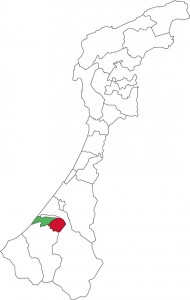
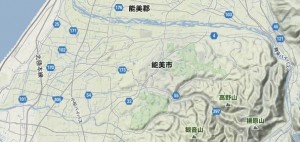

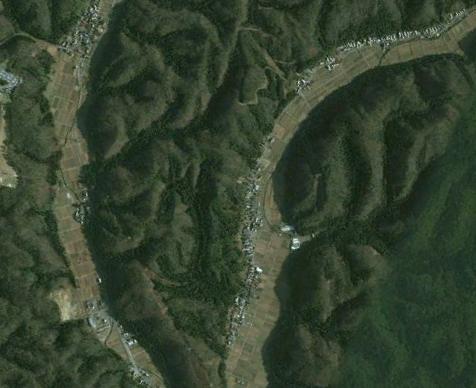
In 1995, before the multiple town merger and creation of Nomi City, the combined population of three towns (Neagari, Terai, Tastunokuchi) was 42,033. At the time of the merger in 2005, the population was 47,689 and in 2009 the population stood at 48,634. It is estimated that the population will rise to 52,000 by 2026 (Nomi City Urban Planning Master Plan, 2009). Out of the population of 48,634, the population in the Satoyama areas amounted to 3,763 (as of April 2005); thus, the Satoyama population only amounts to 8% of the total population which is quite small when one considers the size of the Satoyama area in proportion to the total area of the City. The total area of Nomi City is 83.85 km² and Satoyama area is 45 km², thus amounting to 53% of the total area. The breakdown is as follows: Cultivated Land – 19.20 km²; Forests – 35.64 km²; Residential Area – 10.39 % km²; Other: 18.62 km²(1st Nomi Comprehensive Plan). Manufacturing industry is Nomi’s key industry and there are a number of electronic parts and textile manufacturing plants located in Neagari district which faces the Japanese Sea; these manufacturing plants make use of the underground water of the Tedori River.
The breakdown of Nomi’s total production amount of the value added products is as follows: agricultural production: 2,160,000,000 Yen (Agriculture, Forestry and Fisheries Department Statistics, Hokuriku Agricultural Administration Bureau 2007); industrial goods shipment: 252,960,000,000 Yen (Ishikawa Prefecture‘s Industry, Industrial Statistics Survey Report 2008); retail/wholesale product sales: 51,710,000,000 Yen (Ishikawa Prefecture’s Commerce (Wholesale/Retail) Commerce Statistics Survey Report 2007).
1.2 Natural Environment of the Region
The average annual temperature of Nomi City is 14.1 C°and the city gets an average annual rainfall of 2,135. 4 mm. The summer in Nomi is hot and winter brings a lot of snow, which is typical for areas situated by the Japanese Sea.
The Satoyama region in Nomi has a number of secondary nature areas such as planted forest, secondary forest as well as paddy fields and it is possible to see some rare animal and plant life in this area. So far 1036 types of plant have been identified in Nomi, consisting of 295 trees and 741 herbaceous plants (Nomi City Plant Survey Report 2008), out of which 96 are endangered species.
The northern and southern habitat limits of many animals found on the Japanese Archipelago overlap in the area of Nomi and consequently the vegetation is also rich in the area. Some of the unique animals identified in the Satoyama areas include the umbrella species of Asiatic black bear, serow or raptor species such as osprey, owl, Japanese which is designated as Natural Monument, or the wild boar which has been the cause of damage to human communities in recent years and so on. The reason behind such rich natural environment is the fact that there have not been any major development projects in the Satoyama area after the high economic growth period and the volume of secondary natural area has not changed in last 30 years. However, the lack of management has been conspicuous at the same time and it is evident in the abandonment of paddies, vegetation transition, and death of pine trees, oak trees as well as in the rising phenomenon of increasing size of miscellaneous trees.
2. Local Resources of Satoyama Region
2.1 Utilization of Satoyama Resources after WW II
Nomi’s Satoyama area lies mostly along the A-Class river of Tedori and mountain streams of the Kakehashi river system and the Satoyama resources are used mostly by the satochi area (residential areas and paddy fields). In the hilly areas sandwiched between the mountain streams and SATOCHI, there are planted cedar trees in the lower grounds, and coppice along theridge of the higher area.. Rice paddy cultivation in the Satochi area situated alongside mountain streams has a long history; however, due to shortage of people, in recent years, the cultivation work is carried out by agricultural corporations with the help of large machinery. In spite of this, there are certain communities in this area where the entire cultivation land is found abandoned owing to reasons such as lack of sun light, wildlife nuisance, shortage of successors, etc.
Until about half a century ago, people used to make charcoal as they moved from one place to another in the forest and those traces can be found even today; however, in recent years the traditional mobile charcoal kiln style has been replaced by a fixed charcoal kiln. Today, there is only 1 professional charcoal maker left in the city and there is only 1 kiln left in the city. Today there are very few old houses left with traditional irori (sunken hearth cut in the middle of the floor) or that use kitchen stoves and as a result of this, there has been a sharp decrease in the use of forest resources required to produce heat energy and people rarely use fallen leaves as a compost; this has led to a lack of circulation of forest resources and the forest management.
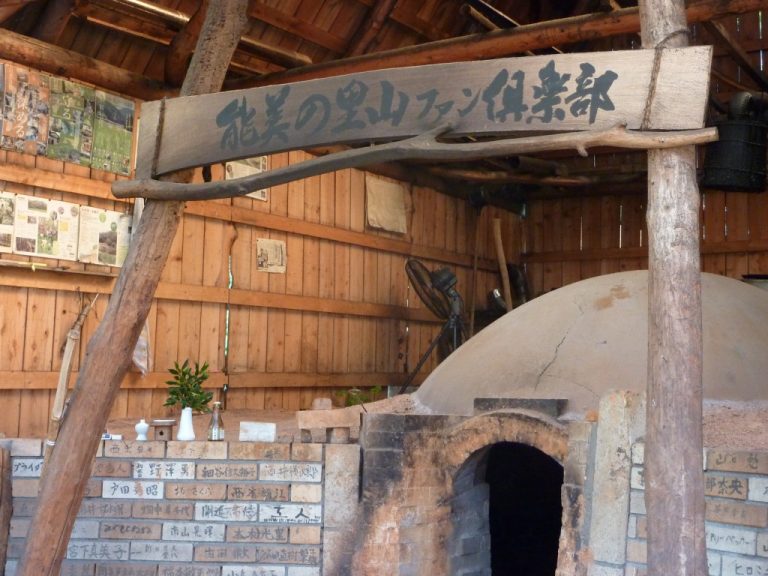
2.2 Use of Satoyama Resources and Its Effects on the Ecosystem
Nomi’s Satoyama areas have seen a sharp increase in the aging population. In the short span of a quarter of a century, the general aging rate for this area has jumped to 26.9% from 13.3 %. In 5 out of 17 Satoyama communities, the rate of the aging population has exceeded 30 %, while according to statistics the rate has crossed 46% for one community, making it practically a “marginal community”. Due to an increase in the aging population, there has been a significant lack of maintenance of woods and many of the satochi fields or paddies located in the valley also lie abandoned.
Due to the derelict fields and mountain streams, there has been a decrease in human traffic as well as a sharp reduction in agricultural pesticides; however, it has been found that as a result of this, the numbers of critically endangered Abe’s Salamander have increased.
Based on the national and city policies, the management of planted forests (cutting certain portion of trees) is being carried out actively and the condition of planted forests in Nomi is quite good as compared to similar forests in other cities or towns (40% of planted forest was thinned out in 2009). However, the use of heavy machinery in managing such planted forests can pose a threat to the habitat of animals, some of which are designated as rare and therefore it is necessary to have a minute assessment of the environment. Although the management conditions of the planted forests are better in comparison as mentioned earlier, such management is limited to simple care or looking after. The environment cannot be said to be ideal for the ecosystem since there are a number of problems such as decrease in the amount of snowfall, aging and decrease in professional hunters’ population, multiple incidents of crop damage by wild boars, appearance of black bears in the Satochi or residential areas and so on.
2.3 Utilization of Regional Resources of Satoyama Area / Ecosystem Conservation Activities
In 2010, Nomi city drew up a plan called “Nomi City Basic Environment Plan” which aims at carrying out measures related to conservation and creation of environment; the sub-theme of this plan was “protection and nurturing of the rich nature of Satoyama, Satoumi & Satochi and its beautiful landscape”. The city administration has been playing its part through a number of Satochi and Satoyama preservation activities such as: 1) Protection of rare species and conservation of ecosystem, 2) Promotion of development of forest and Satoyama, 3) Supporting forest/Satoyama conservation activities carried out by NPO, 4) Supporting volunteer efforts to restore abandoned cultivation land or use such land as citizens’ farm development project, 5) Promote and support use of forest resources as natural energy, and so on.
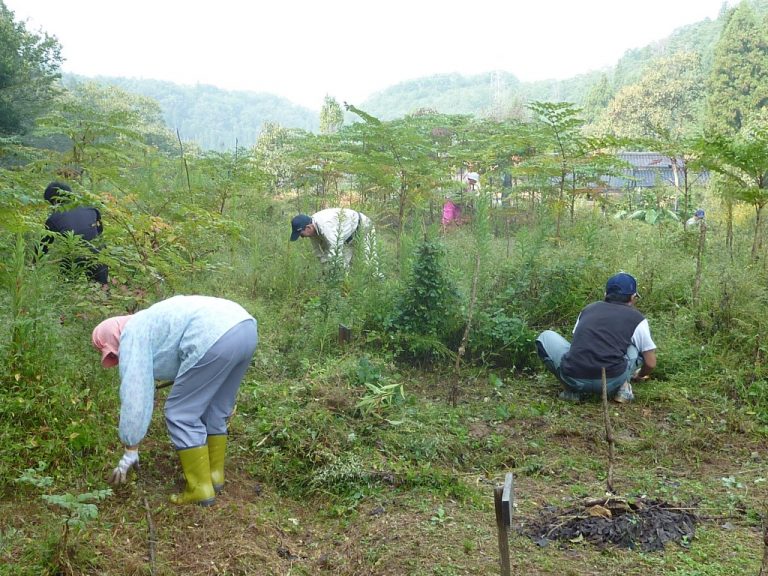
3. Nomi Satoyama Conservation Society (Nomi’s Satoyama Fan Club)
3.1 Background behind the Establishment of the Society
The two trends of depopulation in secluded places in mountains and aging population have not changed in Japan and the issues such as rising cases of abandonment of arable land and destruction of mountain forests have become serious social problems; these problems exist in the secluded mountain areas of Nomi as well and they have become important topics of debate for last 25 years. In February 2006, Nomi City proposed the establishment of a Satoyama Promotion Association with the purpose of revitalizing Satoyama areas and held a meeting with 19 Satoyama communities concerning the issue.
Upon this proposal by Nomi, 6 officials including the first chairman of the Association (2006 ~) took the lead in formulating the outline of the association’s activities and its organizational structure. In March 2006, the association organized a Satoyama Promotion Forum aimed at local residents and this forum helped people understand the gravity of the situation in Nomi’s Satoyama areas as well as made them realize the need for the revitalization activities for the region. This forum also established a solid foundation for the Satoyama Promotion Association, which later came to be called as Nomi’s Satoyama Fan Club(Nomi Satoyama Conservation Society).
3.2 Outline of the Organization and Its Activities
(June 2006, at the time of its establishment) Members: Executive officials: 4; Directors: 18; Part-time staff: 5 Activities: Charcoal kiln making, Nature Walks (4 times), Development of a nature trail route; Mushroom inoculation, Satoyama craft (making of kanjiki : Japanese traditional style snow shoes), publication of information journal
(Year 2007) Members: Association members: 96; 3 organizations, 4 industries, 4 executive officials, 21 directors, 1 permanent staff and 7 part-time staff Activities: Charcoal making (3 times); Tree planting & forest management project for planting mushrooms (twice); Fallow field regeneration (grow edible wild plants); Creation of 3 nature trail routes; Production and sale of firewood; Citrus fruit fields revitalization work; Hokkori Festival; Nature walk meet-up; Construction of a website; Information magazine publication
(Year 2008) Members: 145 Association members; 5 organizations; 4 industries; 4 executive officials; 19 directors; 3 permanent staff and 8 part-time staff Activities: Charcoal making (10 times); Tree planting & forest management project (13 times); Fallow field regeneration (3 times); Nature walks meet-up (4 times); Satoyama Nature School (6 times); Citrus fruit fields revitalization work (3 times)
(Year 2009) Members: 137 Association members; 5 organizations; 7 industries; 4 executive officials; 16 directors; 3 permanent staff and 8 part-time staff Activities: Charcoal making (10 times); Tree planting & forest management project (18times); Fallow field regeneration (4 times); Experimental cultivation based on natural farming method (11 times); Citrus fruit field revitalization work (3 times) Satoyama seasonal vegetable market (9 times); Nature walks meet-up (4 times); Satoyama Nature School (6 times); Satoyama Nature Classroom (12 times)
3.3 Outline of the Activities
Nomi Satoyama Conservation Society (hereinafter NSCS) aims at the regional revitalization of Satoyama areas. The Society’s activities have 3 main mottos:
1) “Protect: Traditions, Culture, Nature”, 2) Utilize: Environmental Industry and Technology”, 3) “Deepen: Nature Experience and Environmental Education”
The main Society activities can be categorized into 4 types as follows:
1) Conservation and regeneration of Satoyama; 2) Cooperation and support of Satoyama community activities; 3) Creation of industry using Satoyama resources; and 4) Environmental education and human resource development using Satoyama resources
NSCS carries out a variety of activities. The Activity Report of 2009 mentions a total of 82 activities and if one takes into consideration the preparation, preliminary inspection, post-event work, etc., then it would be clear that sometimes the Society conducts a number of activities in the same week. These various activities are supported by an amoeba-like organizational structure which enables a single member to be a part of multiple organizations and contribute to the growth of multiple organizations (an organization does not necessarily grow and there are organizations that decline or perish naturally). As a result, a number of activities, ranging from recreation to semi-professional levels that are planned by groups under our umbrella organization have been increasing.
3.4 Principal Activities
There are 5 main activities that our Society has been continuing since its inception.
These activities are: “Charcoal Making”, “Fallow field regeneration”, “Forest management by Local residents”, “Hands-on Experience & Exchange Activities”, and “Environmental Education”.
Ever since its inception, the principal goal of NSCS’ activities has been the effective utilization of Nomi’s Satoyama resources (especially deciduous broad−leaved forest).
The Society started its activities with making of a charcoal kiln. The idea behind this was to “make a start from a point that would be the point of destination in the end”. In the last 3 years, our Society has conducted Professional Charcoal Maker Training Classes; students who graduated from this class set up a charcoal making group called O-sumi-kai (Charcoal Association) and this group has carried out charcoal making 20 times in 2010.
Although Nomi has many Satoyama areas which are rich in nature, if one takes a closer look, one will find that the area from halfway up the mountain has been left neglected for almost half a century and it has turned into an unmanaged deciduous broad-leaved forest; one can also find many large-sized beech and red pine trees that stand decayed or have fallen to the ground. In order to regenerate such a Satoyama environment, a number of forest management activities are carried out by local residents. Since its establishment, the Society has also been involved in activities such as managing (by removing weed and thinning) the walking trail, encouraging mushroom planting, producing firewood, etc. In 2010, these activities were carried out on the 1st Sunday and 2nd/3rd Wednesday of every month.
There are a number of abandoned cultivation lands, many of which are in the valleys of Satoyama area where there is a rapid rise in aging population. NSCS considers such abandoned cultivation land as a Satoyama resource and one example of utilization of such land is Tsubono-machi where local residents and other volunteer citizens practise “farm ownership”, especially for the farms that cultivate edible wild plants such as udo (Aralia cordata) and tarano-me (Aralia spinosa) since such products find it difficult to reach the markets. One of the goals of such an ownership cultivation system is to encourage land owners from outside the town to come to these communities and have exchanges with the local people (increase people to people exchanges); since the goal is to increase people to people exchanges, this ownership system expects the owners to manage their lands by themselves and in exchange of their time and efforts, ownership charges are not high.
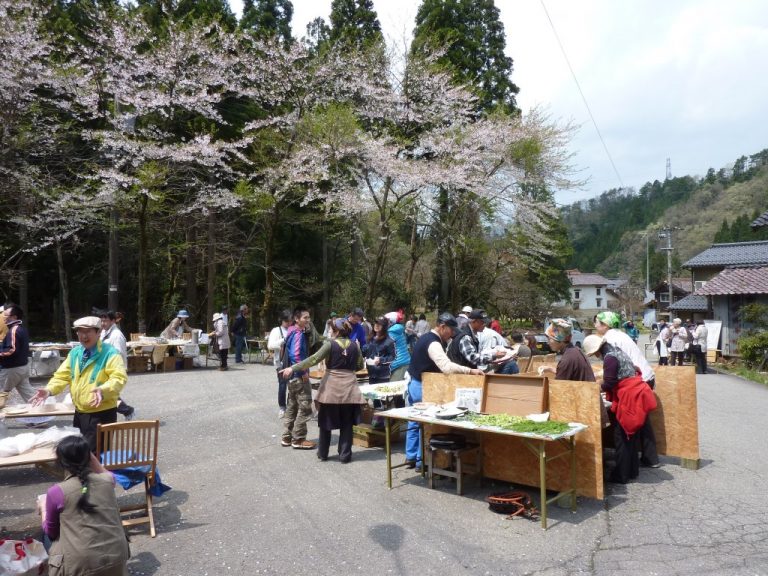
In 2009, a group called Food-Agri School, with a focus on research in natural cultivation was established. This group rented abandoned cultivation land from the local people and started growing vegetables.
In 2010, as a part of its CSR activities, an agricultural implements and machine maker started its regeneration project on a 1.4 ha abandoned cultivation land in Tsubono-machi; in 2011, this land will be cultivated as a citizens’ farm. Since this land was lying abandoned for almost 25 years, it is believed that the soil will not have any agricultural pesticides residue and future cultivation does not foresee the use of any pesticides.
There are a number of hands-on activities that are expected to promote exchanges between people in the Satoyama areas and from the urban areas. It is hoped that such increased exchanges will help preserve and pass on natural environment, history, culture and traditions of Satoyama area. For instance, some of the main hands-on activities that NSCS has been conducting from its year of inception are as follows:
Snow Hiking in kanjiki (Japanese traditional style snowshoes) which involves making one’s own kanjiki and walking on snow; Satoyama Guide Hiking which is held 5 times every year on a regular basis;
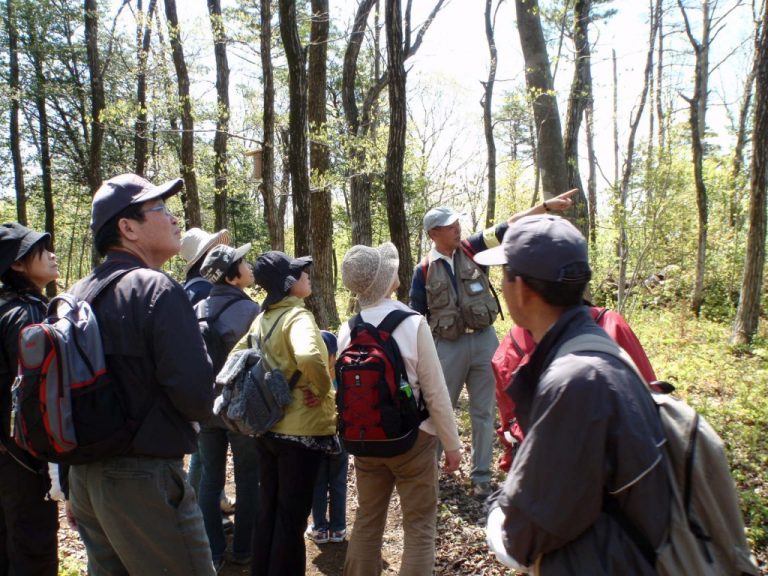
[Photo: Guide Hiking]
Nomi Hokkori Festival was started in 2007 with the aim of revitalizing
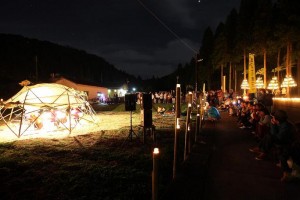
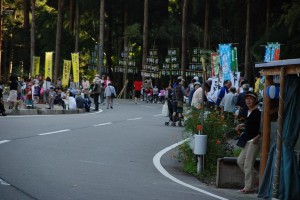
[Photos: Nomi Hokkori Festival]
Butsutaiji-machi which has the smallest population (9 households with 30 people) in the city.
In 2010, which was the 4th year of Hokkori Festival, we organized this festival in collaboration with Tokaido Hokkori Matsuri of Ritto City in Shiga Prefecture. Nomi’s
Hokkori Festival is growing steadily every year and the number of visitors to this festival has risen to 2500 from 1000 in its first year, with the number of stalls also going up considerably to 40 from 11 stalls.
The Nomi Satoyama Nature School began in the 2nd year after the establishment of NSCS, with the purpose of giving a first-hand experience of environmental education to young children through play and games in Satoyama surroundings. Day-long activities are held 4-5 times a year and overnight camp programs are organized once a year, while keeping in mind seasonal suitability of Satoyama. Thanks to the improved recognition of Nomi Satoyama Nature School, the number of applications received for the camp program was almost double the capacity number, as a result of which the 2-day camp was organized twice in 2010.
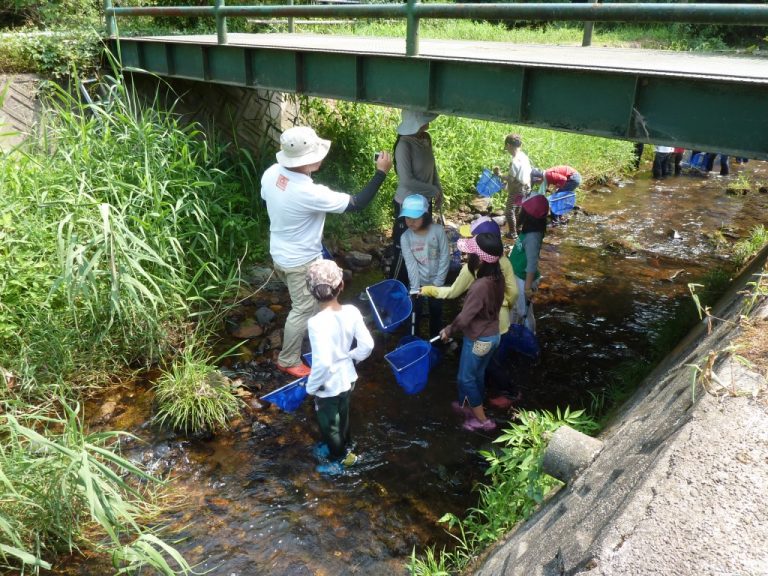
[Photo: Nature School]
The environmental education activities conducted in 2010 were as follows:
June: Walking trail maintenance work, planting of sweet potato;
July: Exploring animal life in fallow fields;
August: Camp, Aquatic life survey of rivers in Satoyama, Woodwork;
November: Exploring animal tracks in Satoyama; Sweet potato baking with fallen leaves;
February: Snow-Hiking in the snow covered Satoyama;
March: Making pizza using edible wild life plants with children and their parents
3.5 Other Activities
Satoyama Nature Classes: A personnel training program aimed at cultivating local leaders from among the local citizens. NSCS hopes that through this program people will be able discover a number of regional resources by themselves as they learn about Satoyama’s nature and culture and also put into practice resource planning and management in order to use these resources more effectively.
Citrus Fruit Field Revitalization: Citrus fruit fields which are not cultivated any more, are rented free of compensation under the Self-Managed Ownership Farm Scheme; the scheme mainly involves activities such as removing weeds twice a year, pruning once and exchange meetings (local residents and the owners).
Nursery in Woods: Satoyama-related activities are organized thrice a year (summer, autumn, winter) for participants in collaboration with a private nursery school.

“Health-up Hike”: Satoyama-Hiking is organized to promote health and health management as a part of the collaboration with a general hospital in Nomi. We also carry out blood pressure and blood oxygen level monitoring before and after the hike, as well as counselling concerning one’s health and warming-up exercises under the supervision of a sports trainer as part of this activity in order to differentiate our hike program from other similar programs.
4. Regional Revitalization through the Use of Natural Resources
4.1 Industrialization of Society Activities
Our Society believes that in order to preserve a favourable condition of secondary natural environment of Nomi’s Satoyama which is a social and ecological landscape, it is necessary to continue activities focusing on Satoyama conservation and regeneration, as well as regeneration of abandoned cultivation land or other activities focusing on Satoyama awareness programs through projects such as Satoyama Guide Hike or Satoyama Nature School.
In order to continue activities mentioned above, it is necessary to improve present activities even further and try to make them unique while trying to increase income through a participation fee at the same time; moreover, it is also possible to regenerate a fertile cultivation land and sell its harvest by using regional resources of Satoyama forest as a source of bio energy and by effective utilization of abandoned cultivation land; the income gained in this way can be returned to the region in some form or the other.
The biggest goals of NSCS is to create a system which is beneficial to people who contributed through their physical labour or through their regional resources and also to commercialize Society activities; we feel that our goal will be realized when it will become possible to sustain such industrialized activities.
4.2 From an increase in people to people exchanges to an increase in residential population
A variety of activities organized by NSCS have helped increase people to people exchanges in the Satoyama area as compared to 2006 and earlier. For instance, the number of visitors to the Hokkori Festival has risen to 2500 from 1000 at the start and out of these 2500 visitors, 40 participants came from outside the Ishikawa Prefecture.
However, the awareness towards such activities among local residents is not very high and there are people who are opposed to activists‘ entry into mountain forest, opinions to refuse outsiders and sale of vacant houses or land lots.. One of the reasons for this is that although there are regular exchanges between the NSCS members and other participants, there are not enough exchange opportunities for local residents to interact with outsiders. The other reason is that because of the aging population, younger population is usually preoccupied with community events (group work or traditional events) and even when NSCS asks community members to participate it is difficult to get their cooperation.
There have been inquiries from participants coming from outside the Satoyama area about vacant houses and the possibility of relocating to Satoyama areas.
4.3 Reforming Local Residents’ Awareness
NSCS has managed to establish strong bonds with 3 out of 19 Satoyama communities through the Society’s regular events and activities. These 3 communities are, 1) Tsubono machi which has the highest aging population rate in Nomi, 2) Butsudaiji-machi which is the smallest village community and 3) Nagataki-machi which is an important center of Takinami Field.
Tsubono is located at the meeting point of two valleys and the main portion of cultivation land was situated along the river side in the valley, however due to factors such as lack of sunshine, damage by wild animals and aging population almost all the land has become derelict. Since 2006 we began considering the possibility of using such land to grow edible wild plants which only have minor circulation volumes in the markets.
There were both Yeas and Nays in the local community but fortunately a voluntary association called Tsubono Sugina-kai was formed which mediated between the local residents and NSCS and it was decided that a part of derelict cultivation land will be used to grow edible wild plants through an ownership system. Since then a Sansai (edible wild plants) Festival is celebrated every year in early spring where land owners and local residents mingle with each other.
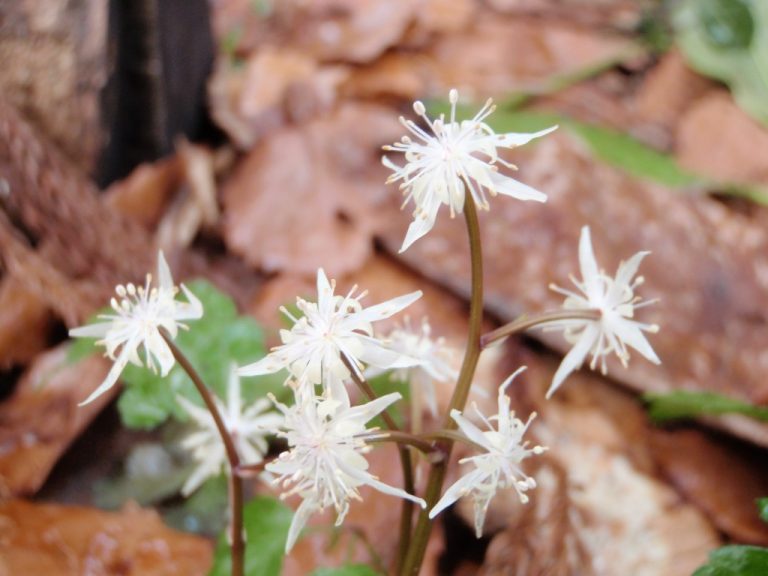
As mentioned above, when a plan was proposed in 2010 to regenerate 1.4 ha cultivation land that was lying derelict, some people welcomed the idea of having outsiders in their community since they believed that their village community would not change unless people from outside the town came to their community, which proved that local people were becoming more receptive to outsiders. Moreover, there are some outsiders participating in Mizu-no-Kai group which is responsible for managing a breeding program of loach on the site of regenerated abandoned land.
Butsudaiji-machi is Nomi’s smallest community with 9 households and a population of 30. In 1889, 6 smaller villages (aza) were reorganized to form Satokawa village in (presently) Komatsu City and in 1907 Kokuzo village (located in the south of Satoyama area) and Yoshikawa village (located in the north of Komatsu City) merged to make Kokufu-aza Butsudaiji. In September of 1934, Mukuroji Tunnel was opened which linked the Satoyama area (north side), thus leading to a shift from Kakehashi river-side community life to present day Nomi Kokuzo district-side community life. Due to these changes, the village children also had to transfer to Wake-Jinjo Elementary School from Kakehashi-Jinjo Elementary School, thus weakening the bonds with 6 aza of present day Komatsu City.
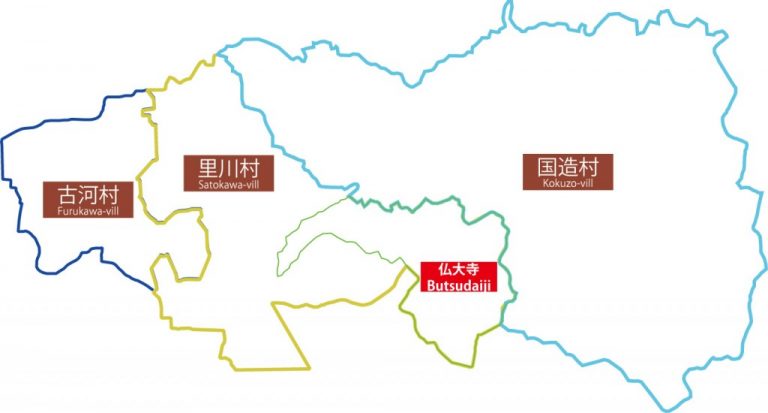
[Regional Map:1889]

[Regional Map:1907 (1)]
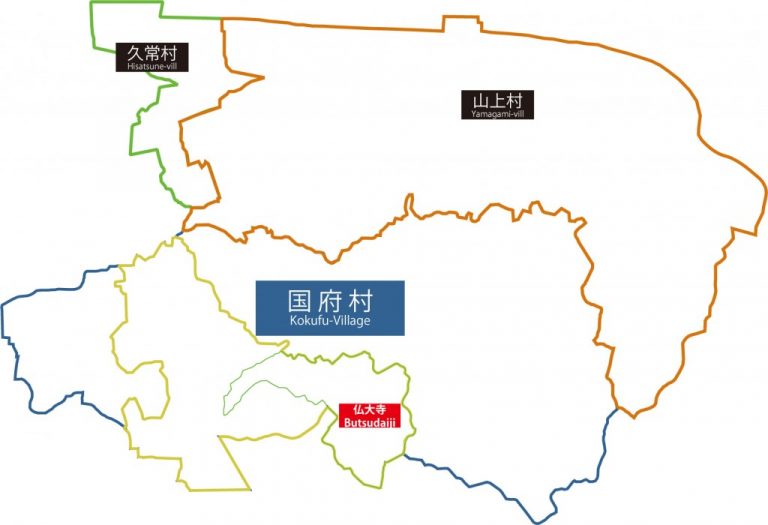
[Regional Map:1907 (2)]
In 1956, 3 villages, namely Kokuzo, Yamagami and Hisatsune merged together to form Tatsunokuchi Town and in year 2005, towns of Tatsunokuchi, Terai and Neagari merged to form Nomi City, thus making Butsudaiji-machi the southernmost village of Nomi, with the tunnel connecting it to the urban areas of Nomi. In 1991, spring-water was discovered near Kannon Temple situated at Mt. Yarimizu-Kannon which is located close to Butsudaiji; afterwards, in September 1996, Nomi City built Yarimizu-Kannon Reisui-do (Sacred water basin). Moreover, in August of 1998, the New Mukuroji Tunnel was opened, making it convenient for vehicular traffic. At present, every day 300 cars on an average come to Butsudaiji to draw the sweet, fresh water from the Kannon water basin.
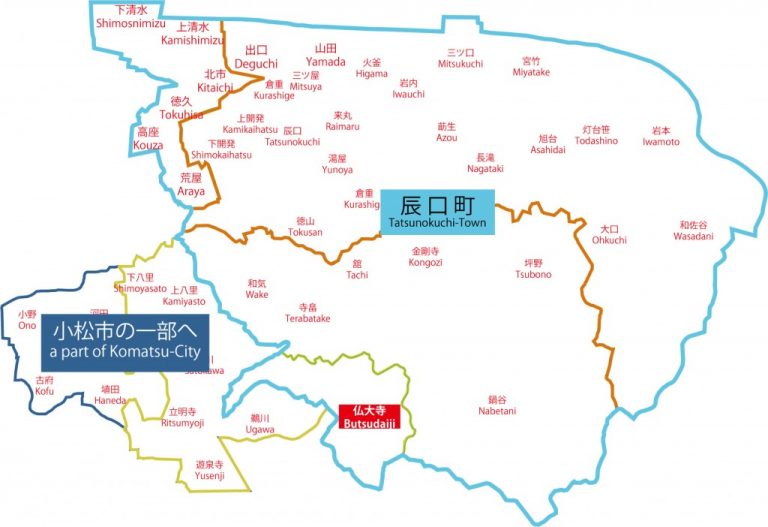
In order to make use of such resources, NSCS came up with an idea to organize the Nomi Hokkori Festival. At first, local people were not very enthusiastic about this idea and they did not want to hold this festival for more than 1 year, but since then this Festival has already been held for 4 years! In fact, at the last review meeting, local people had some very enthusiastic inquiries about the festival such as “what will be the main theme for the next year’s Festival” or “what can we do to make the festival even more original and unique” or “what can be done to improve the hospitality standards” and so on. Besides such positive feedback, we have a few people who would like to open a café in the village after they have retired; thus, it has become clear that increased people-to-people exchanges is helping the revitalization of the region and this has changed the attitudes and level of awareness of local people.
NSCS plans to propose and support projects or activities that suit the respective village communities, after consulting them with the local residents; NSCS hopes that such efforts will not only help change local residents’ attitudes, but also raise the region’s profile.
Bibliography/Sources:
Industry in Ishikawa Prefecture, Industrial Statistics Survey Report 2008, Ishikawa
Civil Cultural Affairs Bureau (2010)
Commerce (Wholesale & Retail) in Ishikawa Prefecture, Commerce Statistics Survey
Report 2007, Ishikawa Civil Cultural Affairs Bureau (2009)
・Tatsunokuchi (1985) History of Tatsunokuchi, Vol. 5 Chapter on Villages
・Nomi City (2006) Nomi Statistics Report 2005 Edition
・Nomi City (2007) The First Nomi City General Plan 2007 ~ 2016
・Nomi City (2009) Nomi City Master Plan concerning Urban Planning 2009
・Nomi City (2010) Nomi Statistics Report 2009 Edition
・Nomi City (2010) Nomi City Satoyama Regional Revitalization Plan Report
・Nomi City (2010) Nomi City Basic Environment Plan
・Nomi City Museum (2005) History of Tatsunokuchi, Vol. 6, Contemporary Age Chapter II
・Nomi City Museum (2008) Nomi City Survey Report on Plants
Link References
・National Census Report 2005
http://www.stat.go.jp/data/kokusei/2005/index.htm
・Hokuriku Agricultural Administration Office (2007) Agriculture, Forestry and
Fisheries Statistics
http://www.maff.go.jp/hokuriku/stat/data/pdf/17_19_15.pdf

